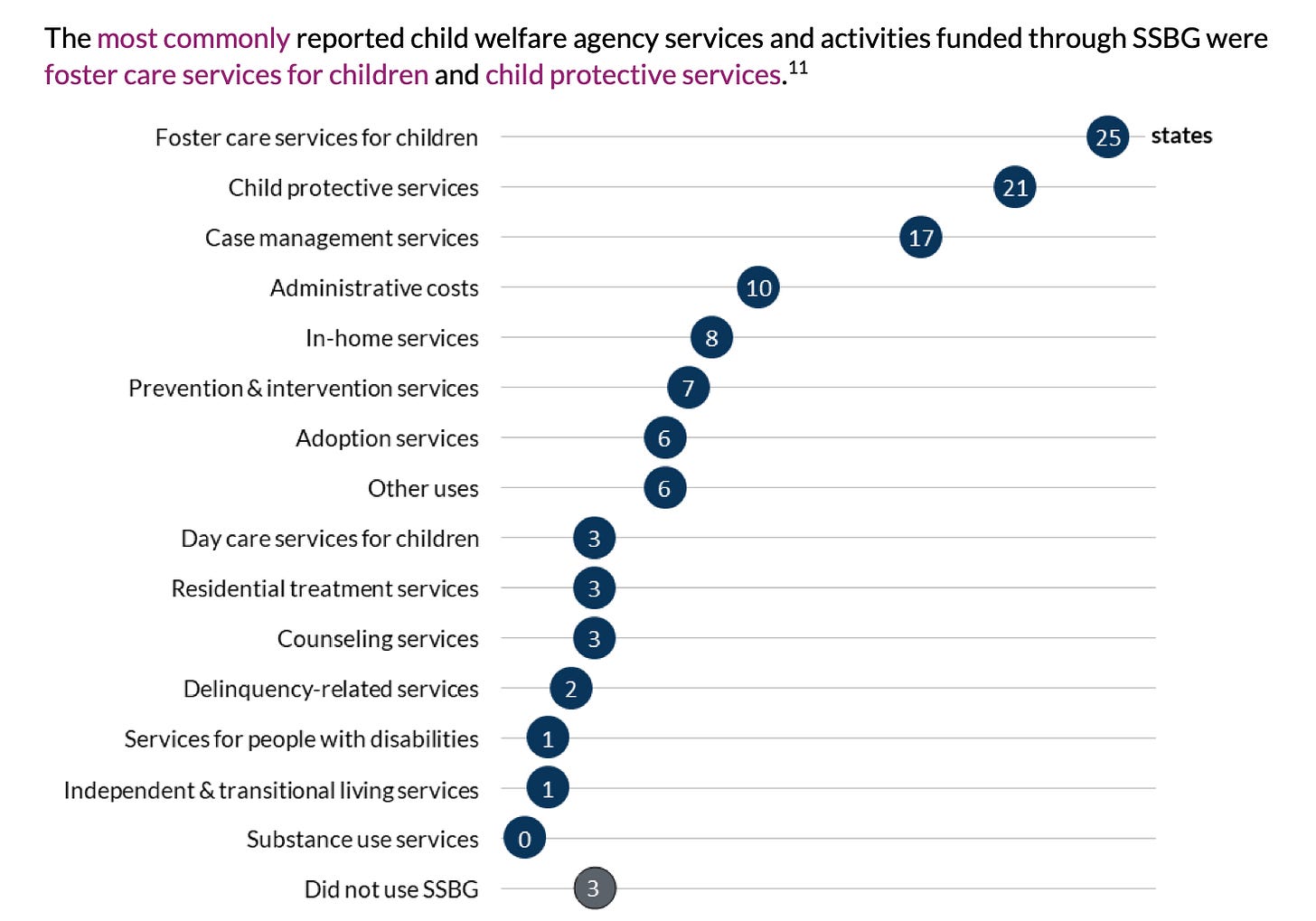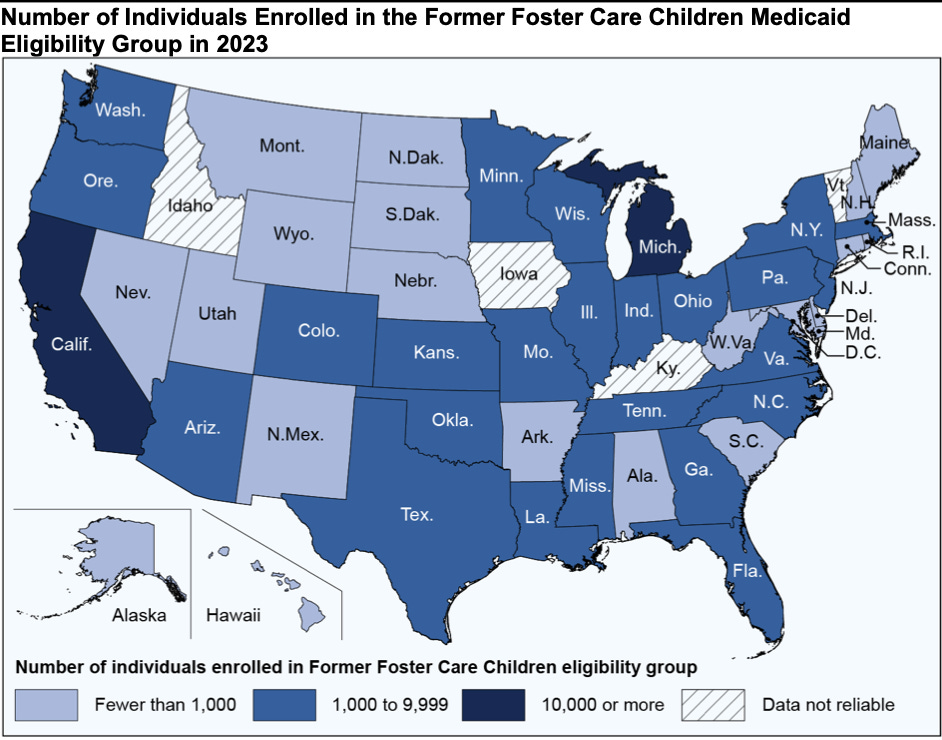Welcome, Wonks! We just hit 1,000 subscribers, so thanks for all your sharing!
On a somber note, rest in peace to Dr. Bob Block, who passed away on February 7th at 81. He was an incredible pediatrician, philosopher, leader, and advocate for children.
President Trump’s new Executive Order is reducing the federal workforce. We are still assessing the child welfare policy role impact.1
The Senate confirmed Robert F. Kennedy, Jr. as Secretary of the U.S. Department of Health and Human Services (HHS), so expect more soon on child welfare policy roles.
There is also a new Executive Order establishing the Make America Healthy Again Commission, with a large focus on children, including on psychotropic medication.
More on all that as we learn more. For now, let’s dig into the big story of reconciliation.
Reconciliation (House Remix)
Last week we unpacked the how of budget reconciliation, now for more of the what.
What Matters for Child Welfare in Potential Reconciliation $ Reductions:
Medicaid
Covers 99% of kids in foster care AND is 7% of federal child welfare funds
Temporary Assistance for Needy Families (TANF)2
19% of federal child welfare spending
Social Services Block Grant (SSBG)
10% of federal child welfare spending (see below!)
We have news here… which means time to talk mixtapes. I know, but hear me out!

Fellow hip hop fans will intuitively grasp what I mean when I say that that reconciliation instructions are more mixtape than album.
For those scratching their heads (“Millennials are entering middle age and still sound like this? I tolerated the avocado toast, but this is too much!”), stay with me.
The so-called golden age of mixtapes was the 2000s and early 2010s.3 Between albums, artists and producers put out these more loose, raw, draft-y projects.
Mixtapes would hone ideas, pulling from elsewhere for remixes and reimaginings. Sometimes they led to incredible albums, and sometimes to creative duds.
This is a lot like the reconciliation process; Budget Committees basically produce some beats for committees to experiment on, hoping it sparks a future hit album.
Right now there’s two competing mixtapes trying to become The Reconciliation Bill.
On February 12th, the U.S. Senate Budget Committee approved its reconciliation instructions, with further action possible this week.
This narrower Senate proposal tracks with what we covered last week; they would prefer to do a second reconciliation bill later this year, which could affect child welfare.
On February 13th, the U.S. House Budget Committee approved its proposed reconciliation instructions. They’re on recess this week, but could move soon.
The House bill is larger, and includes the extension of expiring tax policies. That costs a lot, and so will require significant offsets in reduced spending.
This matters for child welfare because the reconciliation instructions seek savings that could come from child welfare programs. Let’s run the numbers.
House Proposal by the #s
3/27/254-Last day for Committees to send legislation to the Budget Committee
$1.5T Total Minimum Spending Reductions, including:
$880B minimum from House Energy and Commerce
Would primarily implicate Medicaid.
$330B minimum from Education and Workforce
$230B minimum from Agriculture
Likely impact on the Supplemental Nutrition Assistance Program (SNAP).
$4.5T Maximum New Deficit Spending for Ways and Means
Could also include reductions, like SSBG (see below) and TANF.
$4T Debt Limit Increase
Some of the other big upcoming dates to watch for, those include:
March 4th- Trump 2.0’s first address to a Joint Session of Congress
March 14th- Current discretionary government funding expires.
The Debt Limit “X Date”- We hit the debt ceiling, and Treasury is employing “extraordinary measures5” to buy time. Congress has to raise it again soon.6
December 31, 2025- Expiration of many tax cuts in the Tax Cuts and Jobs Act
Medicaid faces the largest potential cuts, since Energy and Commerce has the biggest target. But there are emerging complexities to watch that will make it difficult.
On Medicaid and child welfare, check out this new brief from the Georgetown Center on Children and Families.7 More to come on Medicaid in our next deep dive!
The Road from Mixtape to Album
The shift from writing a reconciliation bill to enacting it is difficult, requiring buy-in from the niche audience of committees AND the mass audience of the full Congress.
This brings us full circle with mixtapes, which similarly show that cult mixtape popularity does not always translate so readily into rave reviews of the future album.
Lil Wayne’s Dedication 2 is an easily defensible argument for best hip hop mixtape of all time8. His subsequent album Carter 3? Not so much…
We will continue to monitor and break this down for you. Now let’s dig in on SSBG…
Deep Dive on SSBG
The Social Services Block Grant (P.L. 95-134, AKA SSBG, AKA Title XX of the Social Security Act) is the highly flexible most-important-program-you’ve-never-heard-of.
SSGB provides 10% of federal child welfare spending, supporting an array of services.
Created in 1981, SSBG is the elder-millennial-oldest-daughter of social services programs; its flexible can-do attitude keeps things going smoothly even amidst chaos.
SSBG Highlights:
Annual SSBG Funding
Key Flexibilities
State investment driven by local community need.
Broad uses tied to key purposes.
States can move up to 10% of their TANF funds into SSBG.
SSBG’s Purpose(s)
SSBG supports five overarching policy goals, with lots of child welfare focus:
Achieving or maintaining economic self-support to prevent, reduce, or eliminate dependency;
Achieving or maintaining self-sufficiency, including reducing or preventing dependency;
Preventing or remedying neglect, abuse, or exploitation of children and adults who are unable to protect their own interests or preserving, rehabilitating, or reuniting families;
Preventing or reducing inappropriate institutional care by providing for community-based, home-based, or other forms of less intensive care; and
Securing referral or admission to institutional care when other forms of care are not appropriate or providing services to individuals in institutions.
Who It Serves (FY 2023)
7 million individuals, including 2 million children.9
What SSBG Does:
SSBG’s Federal regulations10 outline over two dozen service categories:
Many are related to child welfare, including:
Child welfare/youth-at-risk services (the top category by spending);
Adoption services;
Foster care services;
Protective services;
Case management; and
Counseling services.
SSBG’s breadth makes it hard to concisely sum up. SSBG is to child welfare what the Sixth Man is to a basketball team; not your key starter, but an essential team player.
Want to see what kind of numbers SSBG puts up when it comes off the bench? Here’s a chart of states’ most frequent child welfare spending categories:

There are great examples of resources that humanize this impact, including the “Faces of SSBG” report that the National Association of Counties put out in 2017.
HHS also has detailed state profiles worth reading, including:
Summing up, another way to put it is that SSBG is like your younger sibling’s piggy bank. Lacking obvious clarity of what it will buy makes it appealing to impulsively raid.
But! Emptying it comes with unintended consequences, disproportionate to the haul…

Wonk Out:
GAO on Medicaid for Youth Aging Out
The U.S. Government Accountability Office (GAO) has published a new report on Medicaid coverage for youth who age out of foster care.
Who Requested The Report: U.S. Senate Finance Committee Ranking Member Ron Wyden (D-OR).
Why Was This Necessary: Information about coverage for this population has been…complicated. Their higher health needs make it important.
The Affordable Care Act (P.L. 111-148) guaranteed Medicaid to age 26 for youth who aged out, like the law’s dependent coverage to 26 for private plans.
BUT, the Centers for Medicare and Medicaid Services (CMS) later determined that was only mandatory in the state in which the young person aged out.
States could voluntarily cover all youth who aged out, but many didn’t.
The SUPPORT Act (P.L. 115-271) ended this patchwork, ensuring all youth who aged out could access Medicaid anywhere, starting January 1, 2023.
All of this made studying this population more challenging than anticipated.
What GAO Looked At: GAO dug into Transformed Medicaid Statistical Information System (T-MSIS) data from 2023 to understand coverage trends.
What GAO Found:
112,000 covered former foster youth
Barriers to Enrollment:
Missing enrollment outreach from frequent address changes;
Lack of specialized Medicaid agency staff for the population; and
Difficulty coordinating among state agencies.
Select Strategies to Address Barriers:
Simplifying renewal & targeting outreach;
Specialized caseworkers; and
Channeling outreach through trusted messengers.
Wonk Out: Read the report

That’s it for now, and thanks for reading. If you enjoy Child Welfare Wonk, please share with a friend or colleague.
Have a good week, Wonks!
I’m ZLaris.59 on Signal for anyone who would like to connect…
If this is alien to you but you also like hip hop, you could do worse than going down the rabbit hole of DJ Drama projects from the mid aughts…
For context, the first reconciliation bill in the prior administration, the American Rescue Plan Act (P.L. 117-2/ARPA) became law on March 11, 2021
Exact timing is unclear. April tax receipts data will make that much clearer, so expect big headlines this Spring…
Full disclosure, I wrote this brief for Georgetown.
Persuade me I’m wrong!
See this ACF fact sheet.
You can see the full regulations at 45 CFR Part 96, particularly Sections 96.70 through 96.74.

